Effect of Air Gap on Electrical Tree in Epoxy Resin Under High Frequency Bipolar Square-Wave Voltage
Abstract
:1. Introduction
2. Materials and Methods
3. Results
3.1. Electrical Treeing in Epoxy Casting Insulation Samples without Air Gap
3.2. Electrical Treeing in Epoxy Casting Insulation Samples with Air Gaps
3.3. Erosion Effect of Corona Discharge
4. Discussion
5. Conclusions
- With the presence of air gap around the needle tip, the electrical tree in epoxy casting insulation under repetitive frequency bipolar square-wave voltage changes from branch-type to bush-type. At the same time, the growth rate of electrical tree significantly decreases, and the larger the air gap, the slower the growth rate.
- In the range of 1~20 kHz, no matter whether with large air gap or small air gap, discharge in the air gap is more intense, and the growth rate of electrical tree branches increases with the increasing voltage frequency. Different degrees of erosion and deformation have appeared in the tip area of the air gap.
- The multiple effects of discharge erosion, heat accumulation and charge transport determine the electrical tree characteristics. Among them, the spot-like erosion characteristics of the epoxy sample surface under the repetitive frequency bipolar square-wave voltage indicate that discharge will introduce a lot of defects and induce the possibility of multi-directional expansion of electrical trees.
Author Contributions
Funding
Conflicts of Interest
References
- She, X.; Huang, A.Q.; Burgos, R. Review of Solid-State Transformer Technologies and Their Application in Power Distribution Systems. IEEE J. Emerg. Sel. Top. Power Electron. 2013, 1, 186–198. [Google Scholar] [CrossRef]
- Leibl, M.; Ortiz, G.; Kolar, J.W. Design and Experimental Analysis of a Medium-Frequency Transformer for Solid-State Transformer Applications. IEEE J. Emerg. Sel. Top. Power Electron. 2017, 5, 110–123. [Google Scholar] [CrossRef]
- Zhang, J.; Du, Y.; Li, Z.; Wang, P. Design of a Medium Frequency, High Voltage Transformer for Power Electronic Transformer; Institute of Electrical and Electronics Engineers (IEEE): Piscataway, NJ, USA, 2014; pp. 1–5. [Google Scholar]
- Shuai, P.; Biela, J. Design and optimization of medium frequency, medium voltage transformers. In Proceedings of the 2013 15th European Conference on Power Electronics and Applications (EPE), Lille, France, 3–5 September 2013; pp. 1–10. [Google Scholar]
- Tian, M.; Du, B.; Su, J.G.; Li, J.; Zhu, L.; Yu, Y. Electrical Tree in Epoxy Resin under Combined DC-harmonic Voltage. In Proceedings of the Condition Monitoring and Diagnosis (CMD), Institute of Electrical and Electronics Engineers (IEEE), Perth, Australia, 23–26 September 2018; pp. 1–4. [Google Scholar]
- Iddrissu, I.; Rowland, S.M.; Zheng, H.; Lv, Z.; Schurch, R. Electrical tree growth and partial discharge in epoxy resin under combined AC and DC voltage waveforms. IEEE Trans. Dielectr. Electr. Insul. 2018, 25, 2183–2190. [Google Scholar] [CrossRef] [Green Version]
- Pandey, J.; Gupta, N. Study of treeing in epoxy-alumina nanocomposites using electroluminescence. IEEE Trans. Dielectr. Electr. Insul. 2019, 26, 648–654. [Google Scholar] [CrossRef]
- Cdonald, H.M.; Morsch, S.; Rowland, S.M. Chemical analysis of tree growth in epoxy resin using AFM-IR spectroscopy. IEEE Trans. Dielectr. Electr. Insul. 2020, 27, 773–781. [Google Scholar] [CrossRef]
- Du, B.X.; Tian, M.; Su, J.G.; Han, T. Temperature gradient dependence on electrical tree in epoxy resin with harmonic superimposed DC voltage. IEEE Trans. Dielectr. Electr. Insul. 2020, 27, 270–278. [Google Scholar] [CrossRef]
- Xie, A.; Zheng, X.; Li, S.; Chen, G. Investigations of electrical trees in the inner layer of XLPE cable insulation using computer-aided image recording monitoring. IEEE Trans. Dielectr. Electr. Insul. 2010, 17, 685–693. [Google Scholar] [CrossRef] [Green Version]
- Zhang, S.; Yang, Y.; Li, Q.; Hu, J.; Zhang, B.; He, J. Different microscopic features of AC and DC electrical trees in insulating polymer. IEEE Trans. Dielectr. Electr. Insul. 2018, 25, 2259–2265. [Google Scholar] [CrossRef]
- Iddrissu, I.; Zheng, H.; Rowland, S.M. DC electrical tree growth in epoxy resin and the influence of the size of inceptive AC trees. IEEE Trans. Dielectr. Electr. Insul. 2017, 24, 1965–1972. [Google Scholar] [CrossRef]
- Champion, J.V.; Dodd, S.J. Systematic and reproducible partial discharge patterns during electrical tree growth in an epoxy resin. J. Phys. D: Appl. Phys. 1996, 29, 862–868. [Google Scholar] [CrossRef]
- Li, M.; Wu, K.; Zhang, Z.; Cheng, Y. Effect of toughened epoxy resin on partial discharge at solid–solid interface. Plasma Sci. Technol. 2017, 19, 25401. [Google Scholar] [CrossRef] [Green Version]
- Zheng, H.; Liu, F.; Rowland, S.; Chen, S.; Lv, Z. The impact of air gaps between needle and polymer on electrical treeing in needle-plane samples. IEEE Trans. Dielectr. Electr. Insul. 2020, 27, 739–747. [Google Scholar] [CrossRef]
- Wajima, A.; Ehara, Y.; Kishida, H.; Sakai, T.; Ito, T. Tree initiation from artificial void with semiconductive electrode in PMMA. In Proceedings of the Proceedings of 4th International Conference on Properties and Applications of Dielectric Materials (ICPADM), Brisbane, Australia, 3–8 July 1994. [Google Scholar]
- Tanaka, T.; Reed, C.W.; Devins, J.C.; Greenwood, A. Effects of gas phase on tree initiation in polyethylene. In Proceedings of the Conference on Electrical Insulation & Dielectric Phenomena, Pocono Manor, PA, USA, 30 October–2 November 1978. [Google Scholar]
- Zhang, Y.; Zhang, L.; Zhou, Y.; Chen, M.; Huang, M.; Liu, R. Temperature dependence of DC electrical tree initiation in silicone rubber considering defect type and polarity. IEEE Trans. Dielectr. Electr. Insul. 2017, 24, 2694–2702. [Google Scholar] [CrossRef]
- Akram, S.; Wang, P.; Nazir, M.T.; Zhou, K.; Bhutta, M.S.; Hussain, H. Impact of impulse voltage frequency on the partial discharge characteristic of electric vehicles motor insulation. Eng. Fail. Anal. 2020, 116, 104767. [Google Scholar] [CrossRef]
- Lv, Z.; Chen, S.; Rowland, S.M.; Carr, J.; Burnett, T. 3D XCT imaging of electrical tree growth in epoxy resin. IEEE Trans. Dielectr. Electr. Insul. 2020, 27, 631–639. [Google Scholar] [CrossRef]
- Tanaka, T. Charge transfer and tree initiation in polyethylene subjected to AC voltage stress. IEEE Trans. Electr. Insul. 1992, 27, 424–431. [Google Scholar] [CrossRef]
- Champion, J.V.; Dodd, S.J. The effect of voltage and material age on the electrical tree growth and breakdown characteristics of epoxy resins. J. Phys. D: Appl. Phys. 1995, 28, 398–407. [Google Scholar] [CrossRef]
- Kurnianto, R.; Murakami, Y.; Nagao, M.; Hozumi, N. Investigation of filler effect on treeing phenomenon in epoxy resin under ac voltage. IEEE Trans. Dielectr. Electr. Insul. 2008, 15, 1112–1119. [Google Scholar] [CrossRef]
- Experimental study on the insulation properties of epoxy casting resins under high-frequency square waveform. CSEE J. Power Energy Syst. 2020, 1–10. [CrossRef]
- Mason, J. Breakdown of solid dielectrics in divergent fields. Proc. IEE Part C: Monogr. 1955, 102, 254–263. [Google Scholar]
- Liu, T.; Li, Q.; Huang, X.; Lu, Y.; Asif, M.; Wang, Z. Partial discharge behavior and ground insulation life expectancy under different voltage frequencies. IEEE Trans. Dielectr. Electr. Insul. 2018, 25, 603–613. [Google Scholar] [CrossRef]
- Wang, Y.; Balachandran, T.; Hoole, Y.; Yin, Y.; Haran, K.S. Partial Discharge Investigation of Form-Wound Electric Machine Winding for Electric Aircraft Propulsion. IEEE Trans. Transp. Electrification 2020, 6, 1638–1647. [Google Scholar] [CrossRef]
- Luo, Y.; Wu, G.; Liu, J.; Zhu, G.; Wang, P.; Peng, J.; Cao, K. PD characteristics and microscopic analysis of polyimide film used as turn insulation in inverter-fed motor. IEEE Trans. Dielectr. Electr. Insul. 2014, 21, 2237–2244. [Google Scholar] [CrossRef]
- Wang, P.; Xu, H.; Wang, J.; Wang, W.; Cavallini, A. Effect of repetitive impulsive voltage duty cycle on partial discharge features and insulation endurance of enameled wires for inverter-fed low voltage machines. IEEE Trans. Dielectr. Electr. Insul. 2017, 24, 2123–2131. [Google Scholar] [CrossRef]
- Wang, S.; Yu, S.; Li, J.; Li, S. Effects of Functionalized Nano-TiO2 on the Molecular Motion in Epoxy Resin-Based Nanocomposites. Materials 2020, 13, 163. [Google Scholar] [CrossRef] [Green Version]
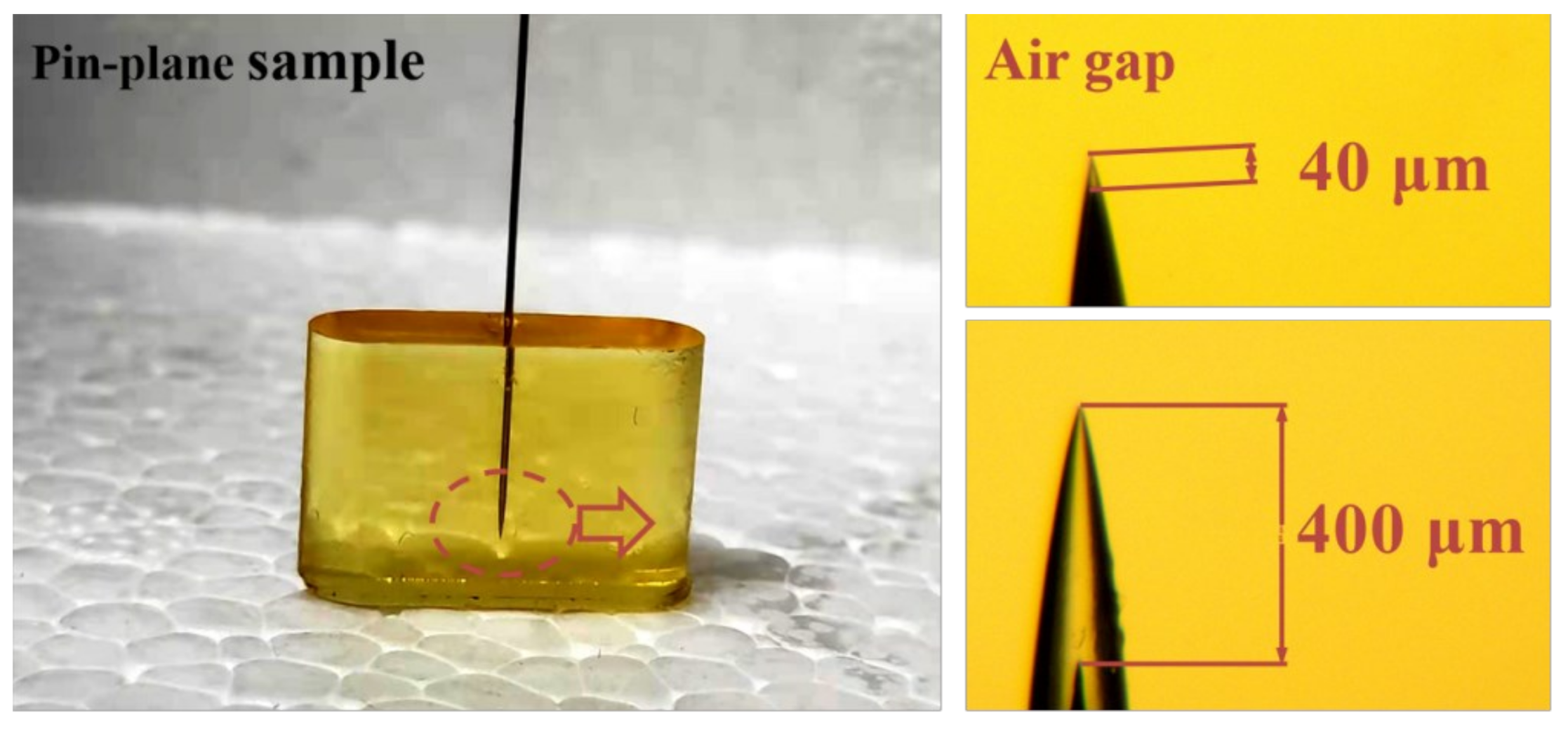

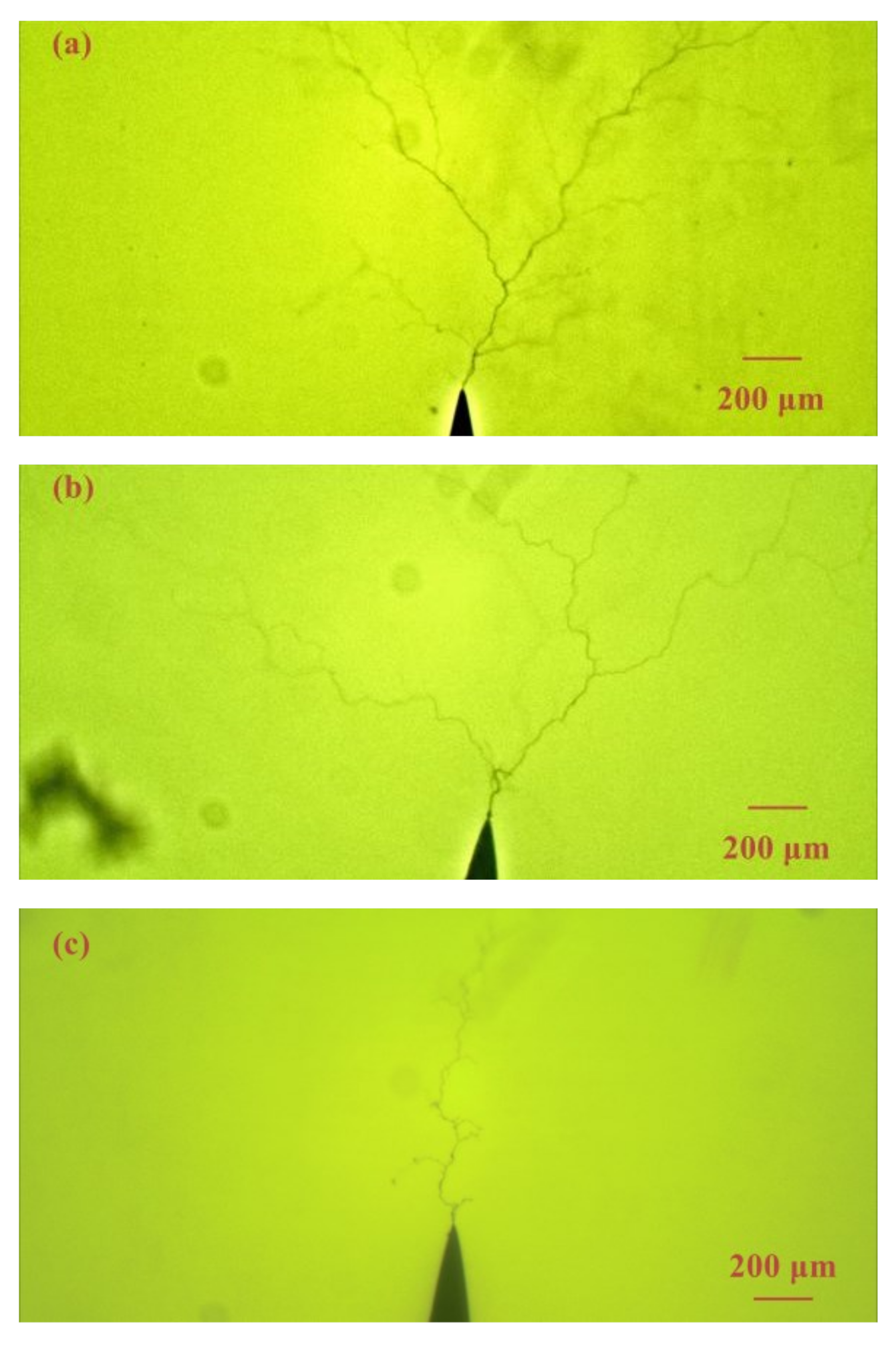

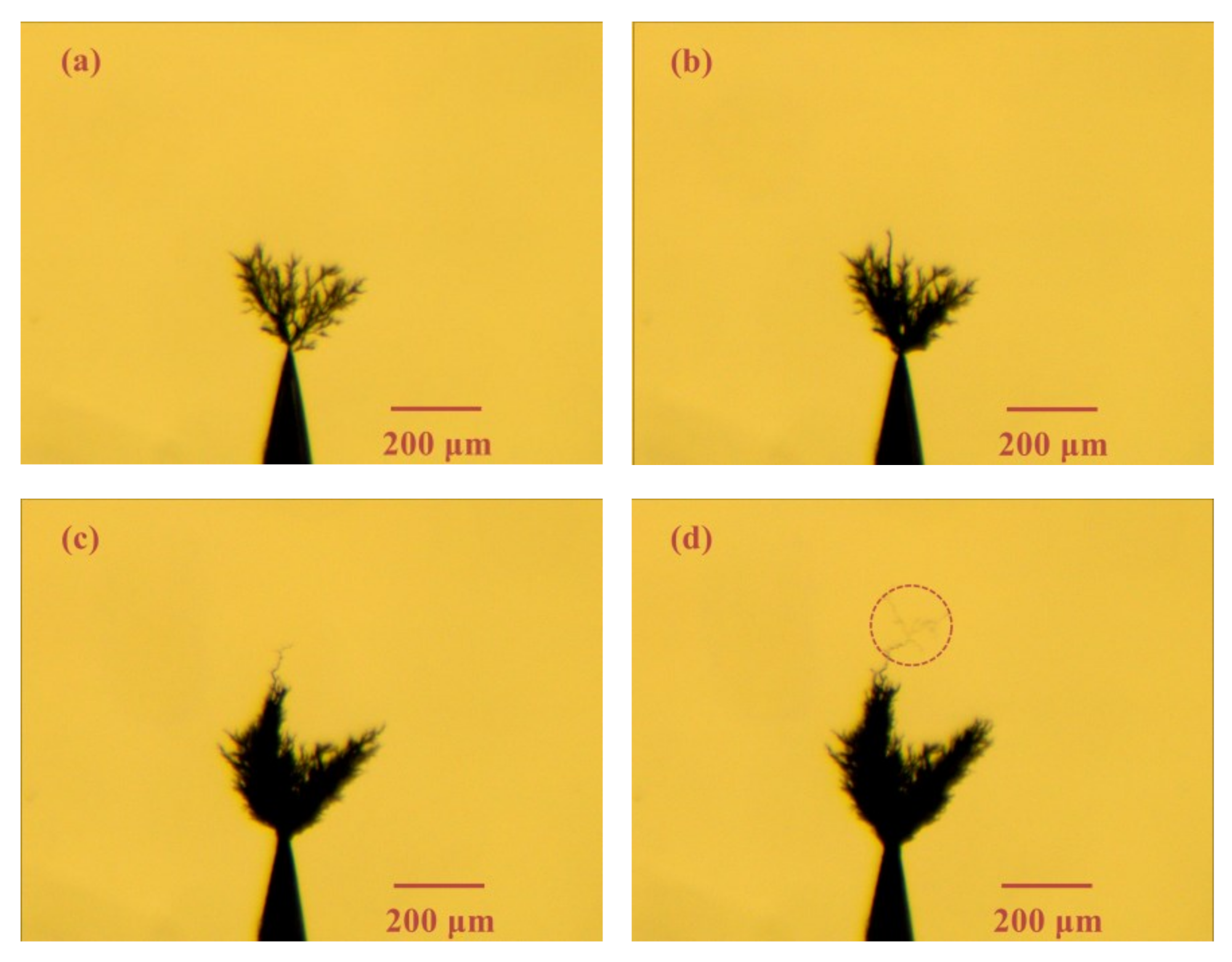
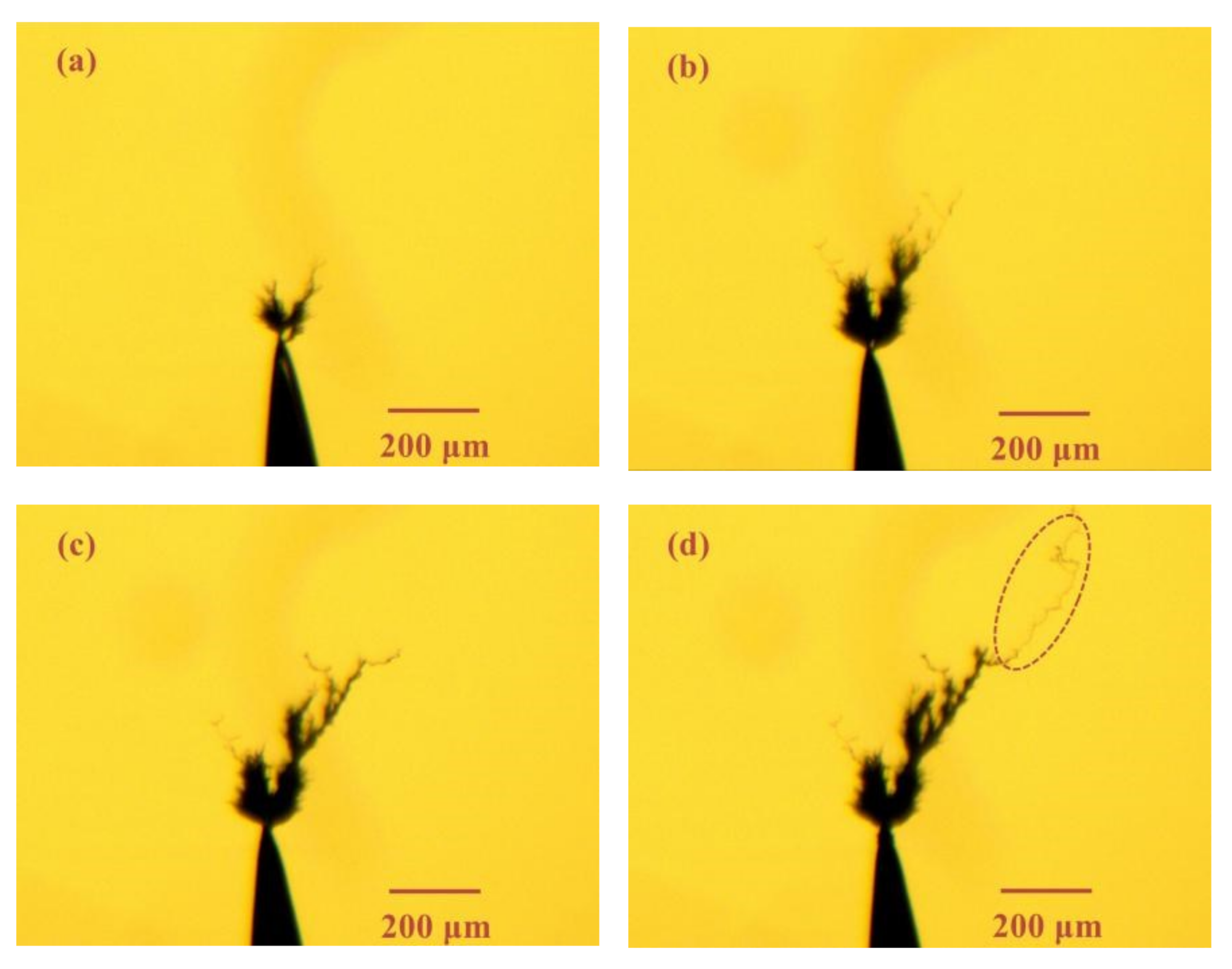



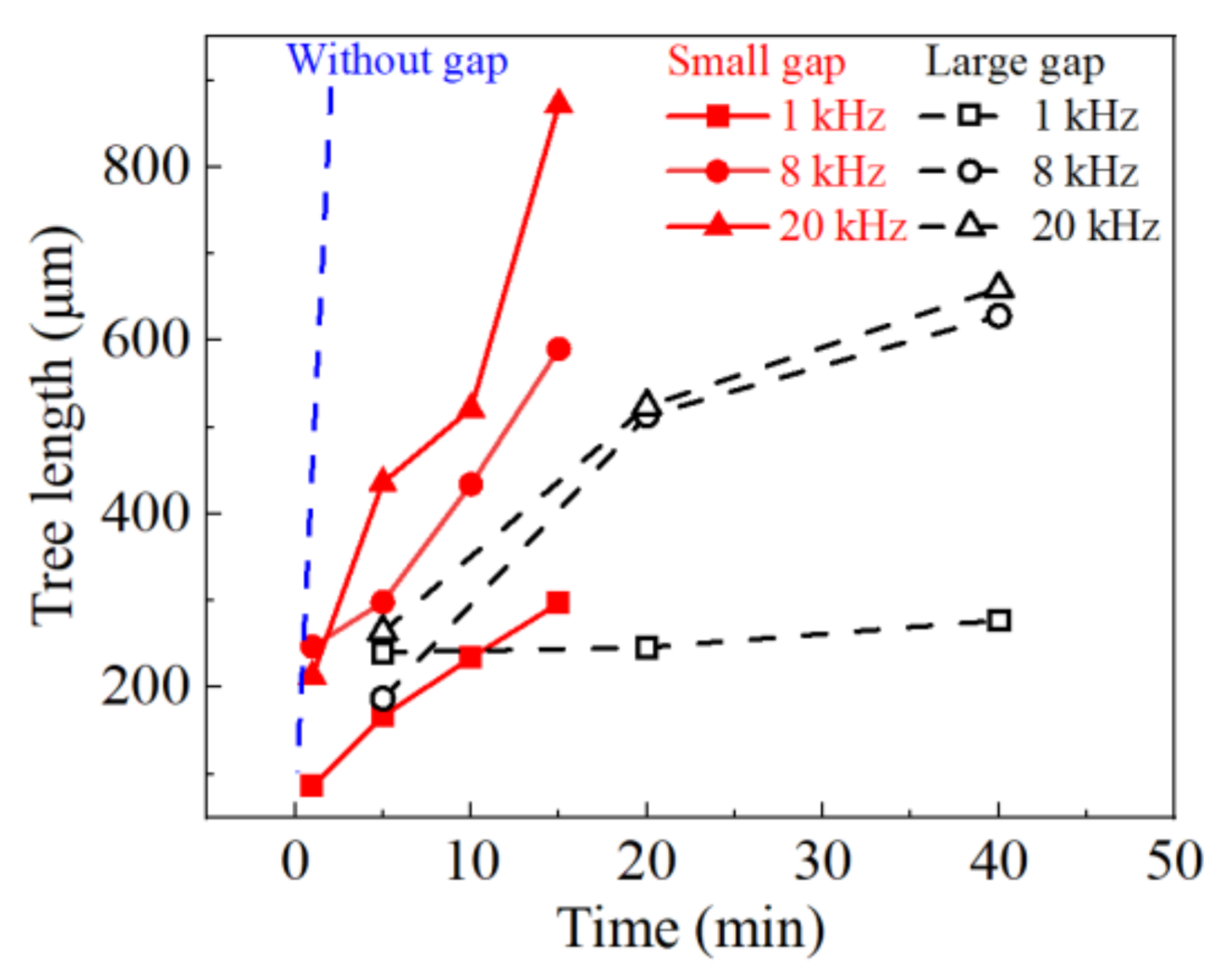
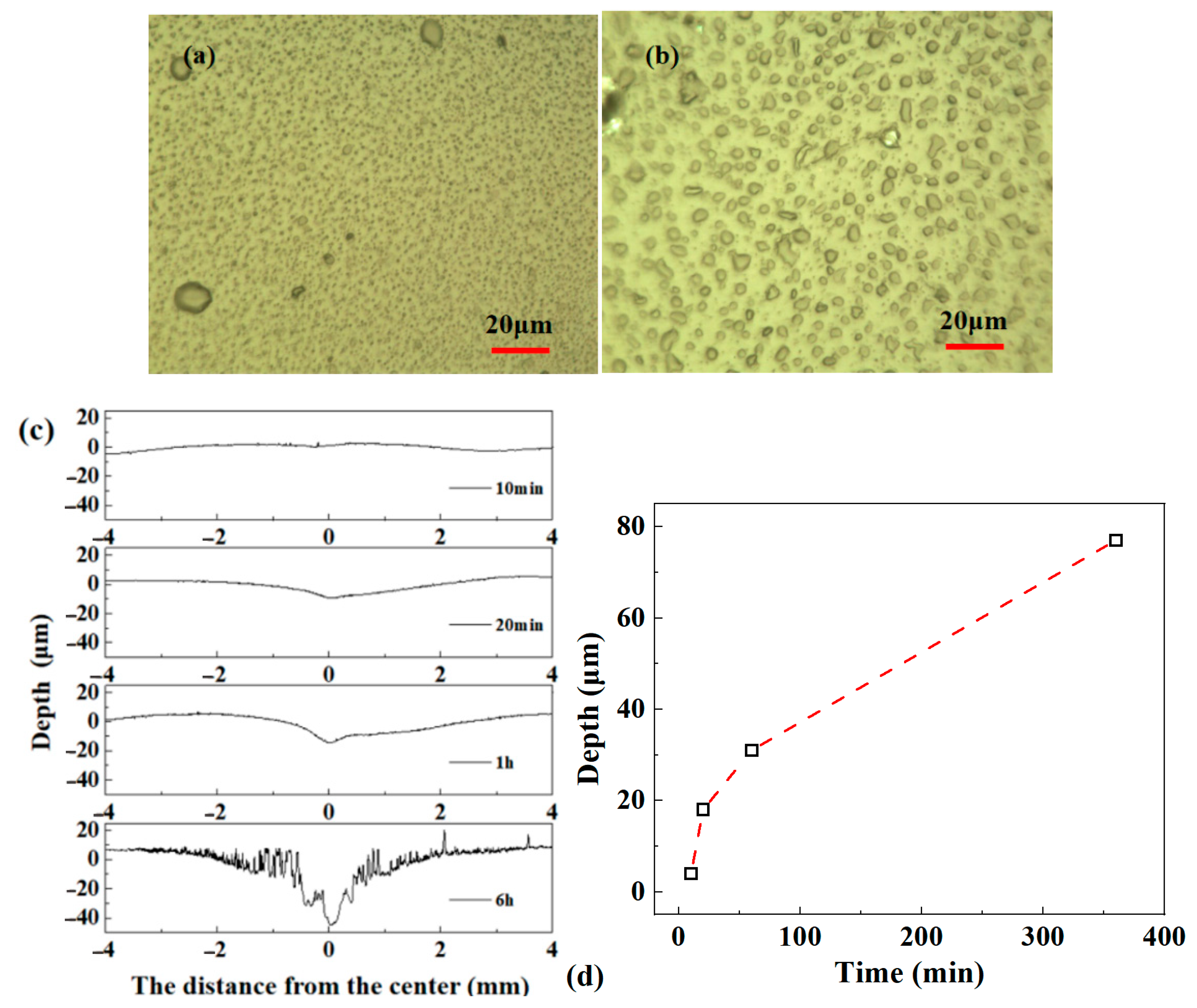
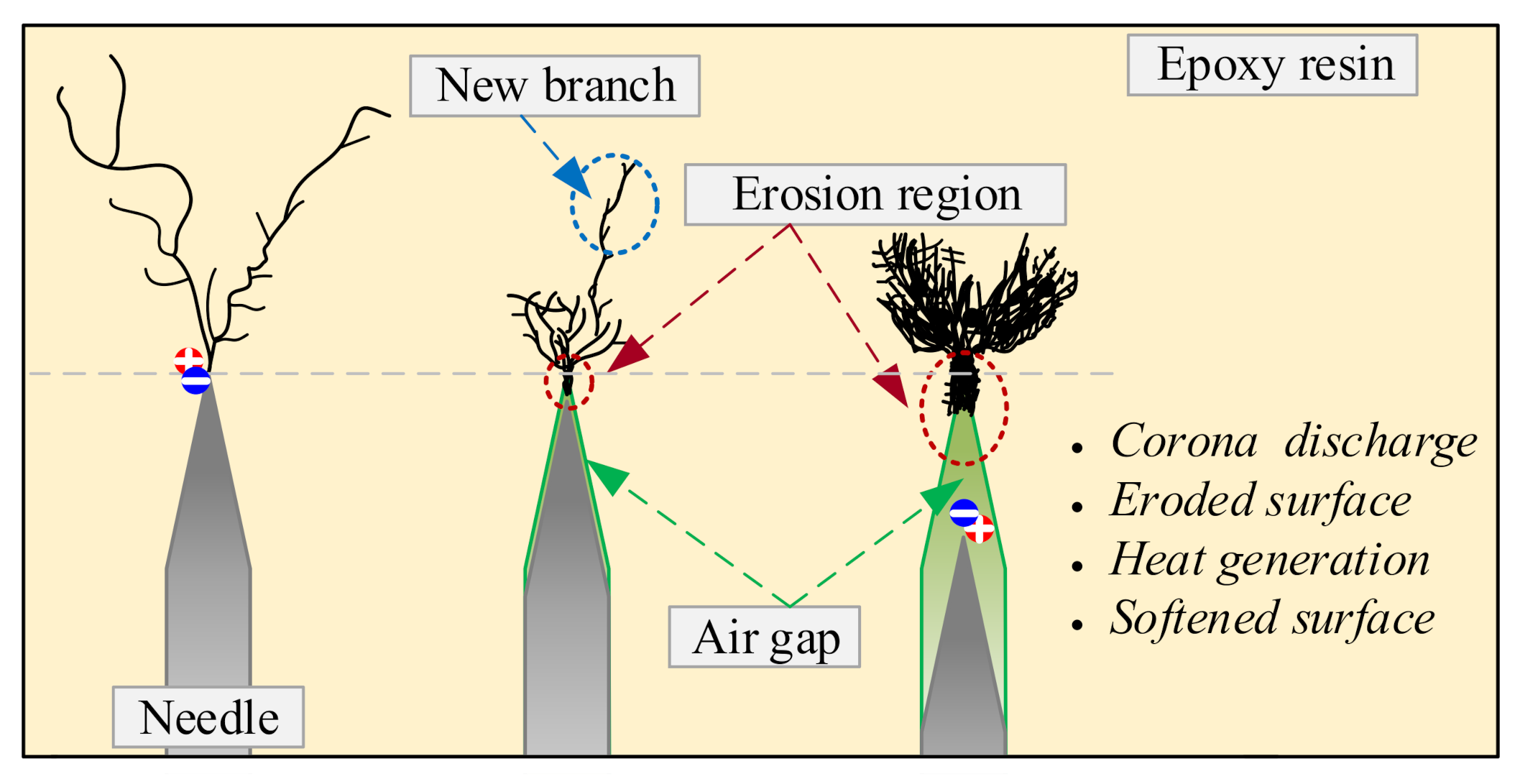
Publisher’s Note: MDPI stays neutral with regard to jurisdictional claims in published maps and institutional affiliations. |
© 2020 by the authors. Licensee MDPI, Basel, Switzerland. This article is an open access article distributed under the terms and conditions of the Creative Commons Attribution (CC BY) license (http://creativecommons.org/licenses/by/4.0/).
Share and Cite
Wang, S.; Zhang, C.; Fu, H.; Xiang, J.; Li, J.; Li, S.; Ouyang, B.; Liu, J. Effect of Air Gap on Electrical Tree in Epoxy Resin Under High Frequency Bipolar Square-Wave Voltage. Materials 2020, 13, 5722. https://doi.org/10.3390/ma13245722
Wang S, Zhang C, Fu H, Xiang J, Li J, Li S, Ouyang B, Liu J. Effect of Air Gap on Electrical Tree in Epoxy Resin Under High Frequency Bipolar Square-Wave Voltage. Materials. 2020; 13(24):5722. https://doi.org/10.3390/ma13245722
Chicago/Turabian StyleWang, Shihang, Chuang Zhang, Hang Fu, Jiao Xiang, Jianying Li, Shengtao Li, Benhong Ouyang, and Jianben Liu. 2020. "Effect of Air Gap on Electrical Tree in Epoxy Resin Under High Frequency Bipolar Square-Wave Voltage" Materials 13, no. 24: 5722. https://doi.org/10.3390/ma13245722




